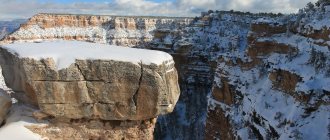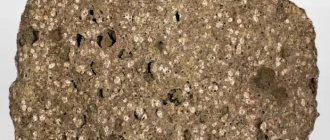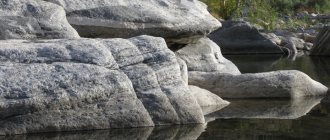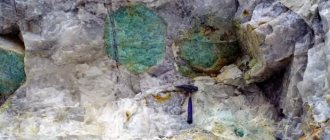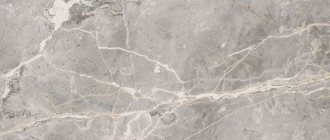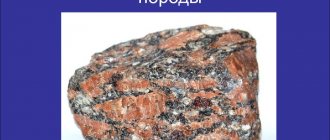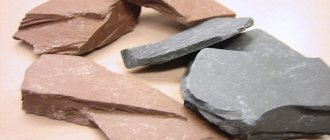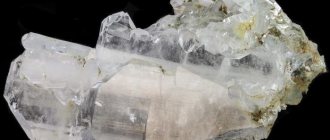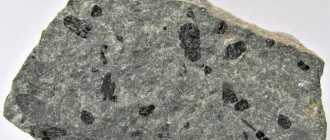What is rock
Rocks are masses of one or more types of mineral components and organic matter. They are formed by natural processes and make up the earth's crust.
In a broad sense, rocks also include water, liquid hydrocarbons and gases.
This is the subject of study of several sciences: lithology, petrography, petrophysics, geochemistry, geodynamics.
The term “rock” was introduced into scientific use in 1798 by the Russian chemist and mineralogist Vasily Severgin.
Classification
A division of rocks of sedimentary origin into groups has been developed in accordance with physicochemical characteristics.
Clastic
They consist of fragments of minerals, remains of biological organisms (calcareous trunks, tree branches, animal skeletons).
This group consists of silts, pebbles, sands and their fragments.
The fragments are cemented by clayey matter of different composition: ferruginous, siliceous, carbonate. But the density is still low - maximum 2 g/cm3.
The dimensions of the fragments are from 0.01 to 10+ mm. They have different shapes (almost always smooth, but not necessarily round).
Volcanogenic-clastic
More often they appear in the literature as volcanogenic-sedimentary or pyroclastic.
They are generated by volcanism, so they are found near volcanoes - active or dormant for hundreds of years. And on land or under water.
In fact, it is a mixture of products of volcanic eruptions: ash, pumice, sand, slag.
Pumice in nature
Clayey
Dispersed products are the result of chemical transformation of aluminosilicate and silicate components of source rocks.
The group combines more than fifty items with different mineral, chemical and organic composition.
The general characteristic of clayey rocks is the dominance of particles of microscopic dimensions (0.01-0.001 mm).
Two types have been identified: clays proper and mudstones.
Biochemical
Biochemogenic and organogenic rocks are created as a result of precipitation from solutions or the concentration of organic substances. The process involves different organisms or their metabolic products.
These are oil, coal, peat.
Varieties
The most popular classification of mineral raw materials is by origin. There are four classes of rocks.
Igneous
Formed as a result of cooling of magma. The composition and properties depend on temperature, pressure, eruption depth, mineral and chemical composition of the melt.
Igneous rocks
Igneous rocks are divided into intrusive and effusive:
- Intrusive. They are formed at depth during slow cooling of the melt.
- Effusive. They solidify when magma reaches the surface.
A type of intrusive rock is hypabyssal rock. They form at shallower depths. Their uneven granular texture allows them to be distinguished from intrusive ones.
Igneous raw materials are classified as primary.
Representatives of the group: basalt, granite (and its variety pegmatite), labradorite, gabbro.
Basalt
Sedimentary
Sedimentary rocks form at the surface or at very shallow depths under low temperature and pressure.
Sedimentary rocks
This is the result of several processes:
- The reshaping of fragments of older ores, resulting in clastic rocks.
- Concentration of waste products of biological organisms.
- Precipitation of chemical elements and compounds from water.
Sedimentary material is considered secondary. It is distinguished by layering and occurrence in layers.
Representatives: peat, chalk, calcite, dolomite, coal, salt, gypsum.
Application of gypsum
Metamorphic
Metamorphic, or altered, ores are created when sedimentary and igneous ores are altered by the environment.
If the temperature causes the rock to melt, it is called ultrametamorphism. This process equates metamorphic rocks with igneous rocks.
Representatives: marble, quartzite, gneiss, shale.
Slate in the interior
Metasomatic
Metasomatic rocks are the result of interaction with liquids. Water, melts of carbonates, silicates, and other compounds pass through the ore stratum. The parent ore remains solid, but when saturated, it changes its chemical composition.
They are easily distinguished by the zonality created by the flow. Moreover, each zone looks different.
Representatives: secondary quartzites, beresites, gumbeites, skarns, albitites.
Dalnegorsk skarn
90% of the volume of the earth's crust is igneous, metasomatic and metamorphic rocks. However, sedimentary (10% of the volume) covers three quarters of the planet's surface.
Material composition
Since the types of HGP differ in their source of origin and characteristics of rock formation processes , they differ in mineral composition, which may include various chemical elements from the periodic table. Complex units contain heterogeneous components in the form of relict minerals, decomposition products of clays or mica, exogenous new formations from true and colloidal solutions.
The components of the UCP are divided into two groups:
- Allotigenic. The substances are clasts, volcanogenic material, terrigenous or cosmogenic components. They come from land or from the bottom of reservoirs. Substances are transported by dragging or as a mechanical suspension, turning into sediment. Allotigenic components resist hypergenic effects. Examples of mineral components are kaolinite, quartz, kistene, feldspars, staurolite, zircon. The degree of mechanical processing affects the shape of the rock, which can be spherical, angular, or unrounded.
- Authigenic. These substances appear in sedimentary rocks at various stages of formation. The components of future HGPs are hydroxides, clay, salts, sulfates, glauconite, chlorites, phosphates, sulfides of some metals and other compounds. The nature of substances is determined by euhedral in pores and cavities, grain structure, spherulitic and oolitic structure, combination or substitution with other minerals.
Based on the stage of formation, authigenic components are also grouped into diagenetic, catagenetic, metagenetic, sedimentary and eluvial. The constituents reflect the physicochemical conditions under which the minerals were formed.
Age
Scientists and geologists determine the age of rock minerals using two scales.
Relative
The age of rocks is determined relative to each other: some are younger, some are older.
This is determined by stratigraphic or paleontological methods:
- The stratigraphic method involves studying the relative position of layers. But only if no movement due to tectonic processes has been observed over millions of years. That is, there was no destruction of the layers, their sequence was preserved. In this case, the higher the layer, the younger the rock. In the very top layers she is the youngest.
- The marker of the paleontological method is fossil organic remains. It has been established that coeval layers contain remains of the same plant or animal species.
Both methods take as a basis the location of rock layers in the earth's crust.
Absolute
The exact age of the deposits is determined by the state of the radioactive elements in the composition.
The degree of decay of radioactive elements is known precisely; it has a constant rate that is not affected by external disasters. This makes it possible to determine the age of the rock with an accuracy of hundreds of years.
Commonly used are uranium-235 or 238, thorium-232, and carbon-14.
The choice of isotope depends on the expected age of the rock:
- For material younger than 50 thousand years (for example, peat), this is an isotope of carbon.
- Isotopes of uranium, lead, thorium, potassium, and samarium are suitable for rocks older than 3.5 billion years.
- Rubidium-strontium, uranium-lead material is applicable to samples aged from one hundred million to five billion years.
To determine age, the ratio of the mass of the newly formed element to the mass of the radioactive isotope used is calculated.
Stages of formation
Sedimentary rocks of different types take millions of years to form. But the stages of the education process are identical.
Diagenesis
Sediment on land or the bottom of a reservoir is an unstable formation of components of different states of aggregation (solid particles, gases, liquids).
Under the influence of bioorganisms in its thickness and external natural processes, the transformation process starts:
- The overlying layers compact the sediment, which leads to its primary dehydration, dissolution, and removal of unstable components (that is, recrystallization).
- The decomposition of the remains of plants and animals changes the chemical parameters of the sediment.
- The final stage of the stage is the cessation of vital activity of most biological organisms, stabilization of the “external environment – sedimentary material” link.
Diagenesis takes tens or hundreds of thousands of years, during which a sedimentary layer 12-55 m thick, sometimes more, is created.
Catagenesis
At this stage, cardinal transformations occur in structure, texture, and mineralogical composition.
They are caused by the influence of the external environment: temperature, pressure, mineralogical composition of water, radiation.
Sedimentary layers become even more compacted, finally dehydrated, and get rid of unstable compounds and bioorganisms.
The result is the formation of new minerals.
Metagenesis
The transformation of sedimentary layers at this stage is caused by the same, but more pronounced natural factors:
- The degree of mineralization, saturation of water with gases, the temperature is higher.
- Redox (Eh), hydrogen (pH) indicators change.
The result is maximum compaction of sedimentary material, changes in mineral composition, structure, and texture. The grains become larger, the randomness in arrangement disappears, and the presence of fauna remains is nullified.
Finally, sedimentary rocks move into the metamorphic group.
Place of Birth
Rocks are the basis of the earth's crust, almost all of their deposits are of industrial importance.
They are classified according to several criteria:
- Type of raw materials. Ore, non-metallic, combustible (hydrocarbons, shale, coal, peat), hydromineral (water).
- Geological structure. Simple, complex, especially complex. The basis is the condition of the layers and the uniformity of occurrence.
- Depth. Depending on it, raw materials are extracted in an open (quarry) or closed (mine) way.
Production volumes are measured in millions of tons, and the price is almost always set per ton. The exception is radioactive and decorative materials. For example, Carrara marble.
Properties and characteristics
Each rock is endowed with characteristics and properties that create its unique description. Among the main ones are structure and texture.
The structure is created by granularity (shape and dimensions of grains), crystallinity, and the ratio of components:
- For igneous materials, the degree of crystallinity is taken into account.
- For sedimentary material, the shape of the crystals is relevant.
- Metamorphic agglomerates are classified according to grain size.
- Metasomatic formations are endowed with a granoblastic structure.
Texture is the relative arrangement and distribution of components in a volume:
- Igneous ones can be homogeneous or heterogeneous.
- In sedimentary materials, a distinction is made between the nature of the surface and the interlayer nature.
- Metamorphic rock formations are represented by spotted, banded, slate, flattened, and other textures.
- In metasomatic rocks, it is inherited from the original components or created in the form of rhythmic layers.
The texture reflects the layering, porosity, massiveness, colors, and shades of the rock.
Areas of application
Unlike precious minerals, rocks have, first of all, utilitarian, applied significance. But they can also bring aesthetic pleasure.
Economic complex
Industry and other industries use rocks of all types:
- Metals, including rare earth and valuable ones, are extracted from ores. For example, gabbro is a source of iron, titanium, vanadium, nickel, copper, and sulfur. Pyroxenites are saturated with iron and platinum.
- Premium-level buildings and interiors are decorated with granite, marble, basalts, and porphyries. Private houses and public buildings are built from brick and concrete.
Marble Palace in St. Petersburg - Roads, highways, and sidewalks are laid with crushed stone, concrete, and bitumen.
- Coal, peat, radioactive raw materials are a source of energy. It is taken by heat, hydro, and nuclear power plants. Coal is used to heat stoves in populated areas where gas has not reached.
- Glass and sand-lime brick are made from sand and sandstones. They are added to concrete, a mixture for covering automobile or railway tracks.
- Dolomite is used in the production of rubber, porcelain, and earthenware products.
Dolomite crystal - Limestone is the source for producing a range of chemicals: hydrochloric, acetic acid, acetylene, caustic soda, calcium carbide, cement.
- Clay is used to produce tiles, dishes, bricks, and porcelain and earthenware products. A special variety is used to purify fats, oils, and juices. It is appreciated by cosmetologists and doctors.
- This is a useful component of agricultural fertilizers.
The food, chemical, machine and instrument making industries cannot do without mountain minerals.
Even diamonds have found use. Ordinary raw materials serve as an abrasive; an elite mountain mineral turns into a diamond.
Its variety, graphite, becomes the lead in pencils and nuclear reactors.
Application of graphite
Other areas
Antique marble sculpture, the Greek Parthenon, and medieval temples have become part of history.
Modern stone carvers are in demand for granite, marble, jasper, and aesthetic varieties of other raw materials. They are used to make statues, candelabra, tableware, carved mantelpieces, and other similar products. As well as an esoteric assortment, sold out by esotericists, magicians, and healers.
Marble countertops
Collectors of mineralogical collections will not miss the opportunity to purchase even an ordinary specimen to complete the assortment.
Typical representatives
The range of minerals of sedimentary origin includes hundreds of names.
The most popular:
- Dolomite. The material has a cryptocrystalline structure (the description resembles porcelain). Dolomite crystal
- Gypsum. Particularly in demand are the varieties of alabaster and fibrous (selenite) - white or yellowish-pink in color with a silky sheen.
- Sandstone. Varieties: gypsum, glauconitic, clayey, ferruginous, calcareous, quartz, siliceous, mica. Determined by dominant material.
- Argillite. Dense dark gray clay.
- Halite. Rock salt.
- Limestone. Varieties: shell rock, coral (from coral polyps), chalk, calcite, tuff.
- Marl. A collection of gray or brown sedimentary rocks made of clay, dolomite and limestone.
Marl - Diatomite The base is opal. Plus clay minerals, quartz, remains of marine organisms (diatom shells, sponges, radiolarians).
- Thrill. Looks like diatomaceous earth. It is possible to distinguish only with special equipment.
- Peat. Material from partially rotted plant fragments.
- Coal. Varieties: brown, stone, anthracite. The latter is the most energetically favorable.
- Oil. Consists of carbon, hydrogen, oxygen compounds, sulfur, nitrogen. Plus organic and inorganic impurities.
- Asphalt. Dense mountain resin with a dominance of hydrogen and carbon in its composition.
- Ozokerite (mountain wax). It happens when light components evaporate from paraffin-saturated oil. Looks like beeswax, but darker. Flammable
Sedimentary rocks include opal and amber.
Fire opal stone
Opals are petrified trees and skeletons of small animals, amber is the hardened resin of coniferous trees 26-31 million years old.
Amber green
Why do you need to study the properties of rocks?
Identifying the properties of rocks is of practical importance:
- Low porosity makes the agglomerate stronger and denser. It is less vulnerable to moisture, but conducts heat and current worse. The situation is similar with graininess.
- Acoustic parameters depend on elasticity.
- Magnetic and electrical characteristics affect electromagnetic properties.
When developing a deposit, the volume of deposits plus the nature of the raw materials are taken into account: hardness, density, integrity, degree of weathering. Based on this, they select equipment, determine the quantity, composition of the team, and the time to complete the work.
The exact physical and technical characteristics of the rock help to develop the optimal technology for their use.
For builders, the massiveness, strength, and abrasion properties of the rock are important. Decorators prioritize beauty and processing capabilities.
